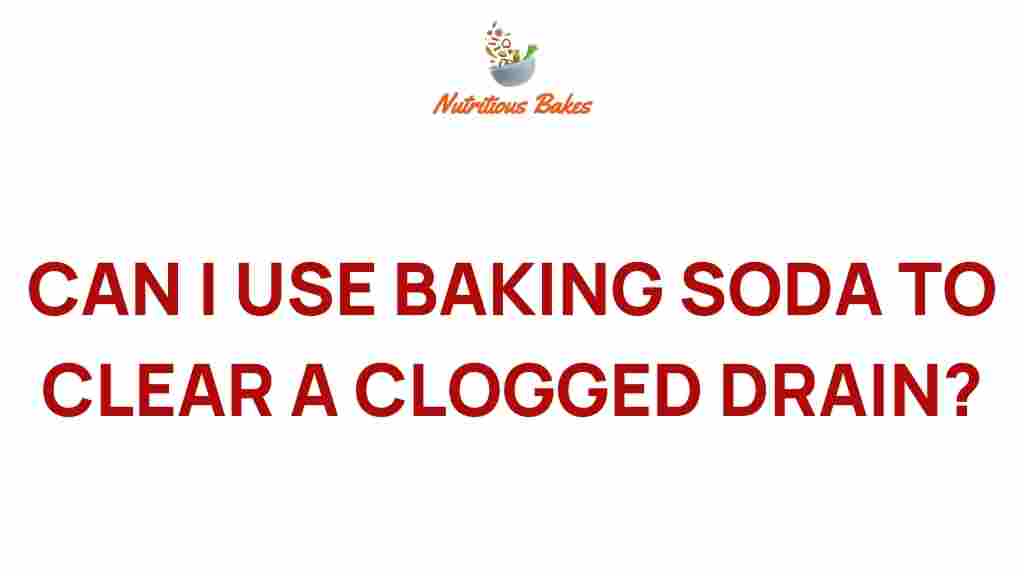Unclogging Secrets: Can Baking Soda Really Save Your Drain?
Are you tired of dealing with a clogged drain? If so, you’re not alone. Clogged drains are a common household issue that can lead to frustrating plumbing problems. Fortunately, there are several DIY solutions you can try before calling in a professional plumber. One of the most popular and effective methods is using baking soda. This eco-friendly cleaning agent is not only affordable but also a powerful natural cleaner that can help you tackle stubborn clogs. In this article, we will explore how baking soda works in drain cleaning, provide a step-by-step process for using it, and offer some helpful plumbing tips.
The Science Behind Baking Soda
Baking soda, or sodium bicarbonate, is a versatile compound commonly found in many households. When it comes into contact with an acid, it produces carbon dioxide gas, which can help break down materials causing your drain to clog. When combined with vinegar, another household staple, it creates a fizzing reaction that can help dislodge debris stuck in your pipes.
Why Choose Baking Soda for Clogged Drains?
Baking soda is a preferred choice for many reasons:
- Eco-friendly: It’s safe for the environment and won’t harm your plumbing.
- Cost-effective: It’s inexpensive and readily available in most households.
- Non-toxic: Unlike many commercial drain cleaners, it’s safe to use around children and pets.
- Versatile: It can be used for other household cleaning tasks as well.
Step-by-Step Process for Using Baking Soda on Clogged Drains
Now that you understand the benefits of using baking soda, let’s dive into the step-by-step process for using it as a home remedy for clogged drains.
What You’ll Need
- Baking soda
- White vinegar
- Boiling water
- Measuring cup
- Cloth or rag (optional)
Step 1: Prepare the Area
Before you start, clear the area around your sink or tub. Remove any items that might get in the way. This will give you easy access to the drain and prevent any accidents.
Step 2: Pour Baking Soda into the Drain
Measure out about 1 cup of baking soda and pour it directly into the clogged drain. Make sure to get it as far down as possible. If the water isn’t draining at all, you can use a funnel to help.
Step 3: Add Vinegar
Next, measure out 1 cup of white vinegar and pour it down the drain on top of the baking soda. You’ll notice a fizzing reaction, which is a good sign that the two ingredients are working together to break down the clog.
Step 4: Let It Sit
Allow the baking soda and vinegar mixture to sit for about 15-30 minutes. During this time, the fizzing will help to dislodge any debris in the pipes.
Step 5: Flush with Boiling Water
After the waiting period, carefully pour about 2-3 cups of boiling water down the drain. This will help wash away any remaining debris and flush the pipes. Be cautious when handling boiling water to avoid burns.
Step 6: Repeat if Necessary
If the drain is still clogged, you may want to repeat the process. In some cases, it may take two or three applications to fully clear the blockage.
Troubleshooting Tips for Persistent Clogs
Sometimes, even with the best plumbing tips, you may encounter persistent clogs. Here are some troubleshooting tips to consider:
- Use a Plunger: If baking soda and vinegar don’t work, try using a plunger. Make sure to create a good seal and pump vigorously.
- Check for Visible Clogs: If you can see the clog, try to remove it manually using gloves and a small tool.
- Consider a Drain Snake: A drain snake can reach deeper clogs that baking soda and vinegar can’t. This tool can help clear out hair and other debris.
- Prevent Future Clogs: Use drain screens to catch hair and debris. Regularly flush your drains with hot water and baking soda to keep them clear.
Other Eco-Friendly Drain Cleaning Solutions
If baking soda isn’t doing the trick, there are other eco-friendly options you can try:
1. Salt and Baking Soda Mixture
Mix 1/2 cup of salt with 1/2 cup of baking soda and follow the same process as above. The salt can help to increase the effectiveness of the baking soda.
2. Lemon Juice
Lemon juice is another natural cleaner. Pour 1 cup of lemon juice down the drain after the baking soda and vinegar mixture. It helps to cut grease and leave a fresh scent.
3. Hydrogen Peroxide
For tougher clogs, you can try using hydrogen peroxide. Pour 1 cup down the drain after the baking soda and vinegar, but ensure it’s safe for your plumbing system first.
For more detailed plumbing tips and solutions, check out this helpful resource.
Conclusion
In conclusion, using baking soda to unclog drains is not only effective but also a safe and environmentally friendly option. This home remedy is easy to apply and can save you time and money on plumbing services. Remember to embrace other natural cleaners and household hacks for maintaining a clean and functional home. Incorporating regular drain maintenance into your household routine can prevent future clogs and keep your plumbing system running smoothly.
So, the next time you face a clogged drain, reach for that box of baking soda and give it a try before calling a plumber!
This article is in the category Tips and created by NutritiousBakes Team
